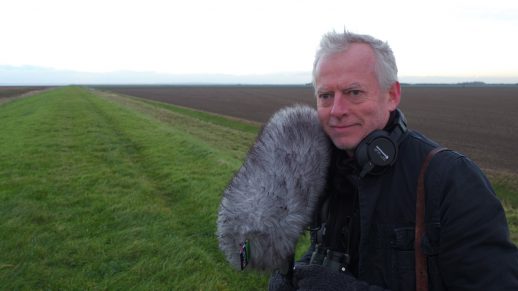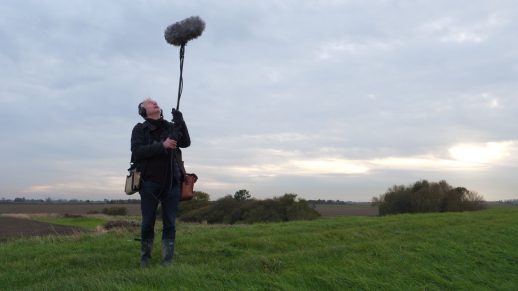Tim Dee introduces Into the Wind, a new film in which he stars, and which is to be aired on BBC Four tomorrow evening. Photos by Richard Alwyn.
I spent a couple of days filming last November on the southern shore of the Wash. I was the subject – or rather, I was to be subjected to the subject. The film records my attempt to capture and record the purest of winds – the wind arriving out of the north before it had hit and sounded off anything or been breathed by anyone. Richard Alwyn made the film. It is on BBC Four on Wednesday 12th April at 7.30pm.
I’ve been a radio producer for a quarter of a century and a birdwatcher for almost twice as long. The wind is busy everywhere but it is keen on being heavily involved with radio – especially sound recording, for good and bad – and birds – especially helping and hindering their flying. Because of this the wind has played an oddly substantial part in my life. For fifty years it has been more than just a soundbed or a backdrop. I’ve sought it out for decades as a key supplier of migrant and rare birds and I’ve avoided it for almost as long as the destroyer of audible voices and intelligible interviews.
More recently, after decades of gathering thousands of human talkers, I’ve fantasised about assembling a library of winds to listen to in my retirement when the talkative world I have spent my career with finally shuts up and I might be left alone to eavesdrop on my reels and cassettes and discs and files of winds, various. For this wildtrack, as we dismissively call it, this atmos, is surely the great song of the earth. Richard’s film indulges me and off I go with my microphone and my dreamy idea out across the flat lands where the sea meets the shore (though neither is certain of either) along the Lincolnshire coast of the Wash. The angles are wide, the colours dour, the sky always there, the soundtrack monotonous, and all birdlife is tiny: this is not natural history TV as we know it.
I learned a lot. Watching myself on screen shouldering a Rycote Windjammer covered microphone – they look like a fluffy dog, a faceless Dougal – I wonder if my thinning grey hair has been gathered over my recent ageing years, like wool on a barbed wire fence, and used to weave a wind baffle. My head and the windjammer don’t differ by much. In another scene my tongue appears and hovers like an indecisive chameleon as I concentrate on plugging in my equipment. I knew my son had that habit and my uncle but not me. My nose runs and eyes water pretty much throughout. The wind operates.
It isn’t pretty. But it wasn’t meant to be. Pure wind might just be a figment of my imagination. And the Wash, though much of its edging is man-made and most of its air is rifled by air force bombers, remains an unsurrendered place. Harsh and flat. But truthful to itself too: a place where nature does its own writing, where the weather channels itself, where the wind makes its own all-day everyday outside broadcast. That was what we were after.
There is a coda to the film, one I discovered watching it and which only occurred to me then. My newish hearing aid is visible throughout. About two years ago a spell of muffled hearing in my right ear gave way to a deranging bout of tinnitus (a particularly cruel species of head-wind in my experience). This seems to have been slain by the arrival of a hearing aid (all thanks to the NHS) that has restored much of what had gone. Was the tinnitus derived from my ear panning for sounds that it had stopped detecting, the infuriating steam-hiss acting as a space holding device, a wind sent from within whilst awaiting the wind from without? I am better now, although electrified, and can still hear goldcrests calling, though I lag 200 metres behind my wife when it comes to grasshopper warblers. But on the Wash listening for the big talker, the pure wind, my device, the genius plastic nautilus filling my ear, boomed and howled around like an unshielded microphone. Our ears (and the auditory nerves and brain behind), I realised, our good ears, are miraculous listeners, able to be open to the air, but not so exposed to it as machines continue to be. And this made me realise that seeking a pure wind, the wind as it might sound in its own ear rather than the sound it makes when running over the sea, or through a wood, or across a field, can only truly be done with our own hearing which itself is a sounding of the wind, an account of its slalom through the listening canals and corridors of our own ears, an account that can only give us a heard wind, its song and not its singer.
*
Into the Wind with Tim Dee, a film by Richard Alwyn, is on BBC Four on 12th April at 7.30pm. Tim has written at greater length about the programme for The Guardian – you can read the piece here.
Tim Dee is the author of The Running Sky and Four Fields. His next book will be about gulls on rubbish dumps, the one after that about the spring.

